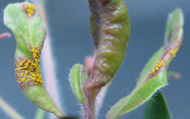PESTS AND DISEASES OF FORESTRY IN NEW ZEALAND
Guava/myrtle rust in Australia
Scion is the leading provider of forest-related knowledge in New Zealand
Formerly known as the Forest Research Institute, Scion has been a leader in research relating to forest health for over 50 years. The Rotorua-based Crown Research Institute continues to provide science that will protect all forests from damage caused by insect pests, pathogens and weeds. The information presented below arises from these research activities.
From Forest Health News 211, December 2010
In April 2010 myrtle rust (Uredo rangelii) was found in Australia for the first time. Uredo rangelii is now recognised as one of the asexual stages of Puccinia psidii the causal agent of guava rust which is a disease of considerable importance in some parts of the world. For the purposes of this article the fungus will be referred to as P. psidii.
Puccinia psidii is a foliar rust and was first recorded on Psidium guajava (guava) in Brazil in 1884. Its hosts are members of the family Myrtaceae. It is native to northern South America and the Caribbean and was found in Florida in 1977, Hawaii in 2005 and California in 2006. It was found in a nursery in Japan in 2007 but is thought to have been eradicated there. There have been unconfirmed reports of it in South Africa and Taiwan. It is regarded as a very serious pest in commercial eucalypt plantations in Brazil.

In Australia the rust was first found on the central coast of New South Wales on the property of a cut flower/foliage producer. Surveys over the next few months, initially focussing on areas that had received material from the source property, indicated that it was quite widespread in plant nurseries, public amenities and areas of forest. There were indications that the disease may have been present for at least two years.
It is not known how the disease entered Australia. Because rust spores are easily transported by infected plant material, contaminated clothing, equipment and by insects, wind and rain splash it was soon decided that eradication would not be possible but efforts were made to contain and slow down its spread and a national management plan is being developed.
Puccinia psidii has been recorded from a wide range of myrtaceous plants including species from the genera Agonis, Callistemon, Eucalyptus, Leptospermum, Lophomyrtus, Melaleuca, Metrosideros, Syzygium, Syncarpia and Tristania. The strain in Australia has been recorded from naturally infected Eucalyptus agglomerata, E. deanei and E. pilularis in New South Wales. Further eucalypt species, E. cloeziana, E. globulus and E. grandis have been shown to be susceptible in pathogenicity tests.
The rust produces lesions on young actively growing leaves and shoots, as well as on fruits and sepals. The leaves may become buckled or twisted. Severe infection can kill shoot tips causing loss of leaders and a bushy habit. Eucalyptus species are most susceptible to infection when they are less than two years old.
Host testing studies that have been conducted outside Australia have indicated that host responses of Australian native plants to the rust infection are very varied under different conditions. The susceptibility of the same species under Australian conditions remains untested. Furthermore several races or biotypes of P. psidii are known to exist and the response of any host species to infection by different biotypes may range from none to severe. It is difficult therefore to predict how the disease will affect the Australian environment but given the variety and the predominance of the Myrtaceae there it could be considerable.
So what does the presence of guava rust in Australia mean for New Zealand? The susceptibility of New Zealand plants has not been tested in inoculation trials. The main concern would be the important genera that the rust has been recorded from overseas, i.e. Metrosideros, Kunzea, Leptospermum, Syzygium and Eucalyptus. Puccinia psidii in Hawaii is affecting native myrtaceous plants including Metrosideros polymorpha, a dominant tree in forests there although information is sketchy on the severity of the damage. Metrosideros excelsa (pohutukawa) and M. kermadecensis (a lesser-known species indigenous to New Zealand) have both been reported as hosts to P. psidii in Hawaii.
The spores of rust fungi are capable of long distance dispersal in the atmosphere. The fact that the poplar rust fungi Melampsora larici-populina and M. medusae arrived in New Zealand from Australia in 1973 is ample evidence of this movement. So as the populations of P. psidii in Australia increase it seems likely that spores of the rust will reach here when atmospheric conditions are right.
If it does arrive here there will be no shortage of suitable myrtaceous hosts so establishment would seem likely. Climate modelling has indicated that much of the North Island and parts of the South Island should be suitable for the development of the rust. As for the effects on plants here your crystal ball should provide some insight.
For further information see:
http://www.anbg.gov.au/anpc/resources.html#Key_issues
http://www.dpi.nsw.gov.au/biosecurity/plant/myrtle-rust
http://www.dpi.nsw.gov.au/biosecurity/plant/myrtle-rust/update
John Bain & Margaret Dick
This information is intended for general interest only. It is not intended to be a substitute for specific specialist advice on any matter and should not be relied on for that purpose. Scion will not be liable for any direct, indirect, incidental, special, consequential or exemplary damages, loss of profits, or any other intangible losses that result from using the information provided on this site.
(Scion is the trading name of the New Zealand Forest Research Institute Limited.)

 Farm Forestry New Zealand
Farm Forestry New Zealand

